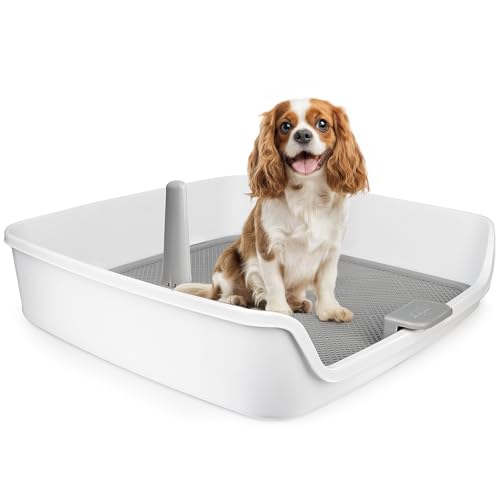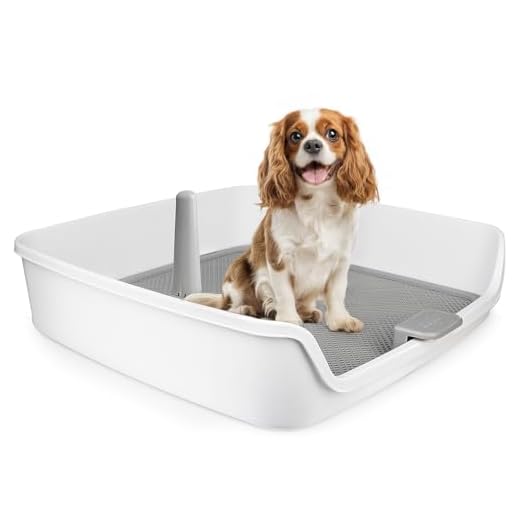




If you’re seeking a canine companion that adapts quickly to indoor habits, consider a Cavalier King Charles Spaniel. These affectionate little ones are known for their eagerness to please, making them receptive to guidance on where to relieve themselves. With consistent reinforcement and patience, many owners report success within a few weeks.
Another breed that excels in this area is the Poodle, particularly the Toy and Miniature varieties. Their intelligence plays a significant role in their ability to grasp commands and routines. I found that using a consistent schedule and rewards worked wonders with my Poodle. A few short months in, and my home was mess-free!
Additionally, the French Bulldog stands out as a solid choice. Their calm demeanor and adaptability simplify the process. By establishing a designated bathroom spot and sticking to it, many pet parents, including myself, have experienced a smoother transition. It’s all about creating a routine that works for both you and your furry friend.
Characteristics of Small Breeds That Aid in Housebreaking
A key feature that makes these breeds easier to housebreak is their high intelligence. Breeds like the Poodle and Yorkshire Terrier exhibit quick learning abilities, allowing them to grasp new commands rapidly. Training sessions become more productive when a pup can understand what is expected of them without excessive repetition.
An additional advantage is their strong bond with humans. Small canines often seek to please their owners, making them more motivated to comply with training guidelines. Establishing a trusting relationship can enhance receptiveness to learning, which is crucial during this phase.
Size plays a role as well; these breeds typically have smaller bladders, leading to a more consistent routine for bathroom breaks. This means that owners can anticipate needs more accurately. Frequent outings are manageable due to their compact stature, making it easier to establish a regular schedule.
Another beneficial trait is their adaptability. Many small breeds adjust well to various living environments, whether it’s an apartment or a house with a yard. This flexibility can facilitate a smoother transition to housebreaking, as they can learn to associate specific areas with bathroom habits.
Lastly, a playful nature often found in these breeds can turn training into an enjoyable experience. Incorporating games and positive reinforcement can keep sessions light-hearted, encouraging the pup to engage actively in learning. This approach not only speeds up the process but also strengthens the bond between owner and pet.
Top Small Breeds Known for Quick Housebreaking
Chihuahuas stand out for their rapid adaptability. With consistent routines, they learn where to relieve themselves in no time. Their intelligence allows them to grasp commands swiftly, making them a popular choice for those seeking a responsive companion.
Pomeranians are another delightful option. Their playful nature often translates into eagerness to please, which can expedite the learning process. Positive reinforcement works wonders with these spirited little ones.
Yorkshire Terriers, or Yorkies, are surprisingly keen learners. Their small size means that even minor accidents can be more easily managed, which often leads to faster learning. Consistency and patience are key with this breed, but the results can be impressive.
French Bulldogs, with their charming personalities, also tend to pick up on cues quickly. They thrive on routine, so establishing a schedule will help them understand expectations regarding bathroom habits.
Beagles, though slightly larger, are worth mentioning. Their strong sense of smell plays a role in their learning capabilities. Using scent to guide them can make the process smoother.
- Chihuahua: Quick learners with consistent routines.
- Pomeranian: Eager to please, benefits from positive reinforcement.
- Yorkshire Terrier: Intelligent and responsive; requires consistency.
- French Bulldog: Thrives on routine; charming and attentive.
- Beagle: Utilises strong sense of smell for effective learning.
Choosing one of these breeds can significantly ease the process of establishing good habits. Their natural instincts and intelligence make them suitable candidates for those looking to minimise challenges associated with housebreaking. Engaging with them positively and maintaining a structured approach will yield the best results.
Steps to Successfully Potty Train Your Small Companion
Establish a consistent routine for bathroom breaks. Take your furry friend outside first thing in the morning, after meals, and before bedtime. This helps create a predictable schedule, making it easier for them to understand when it’s time to relieve themselves.
Choose a designated area outdoors. Consistently taking your pet to the same spot helps them associate that location with going to the toilet. The familiar scent will encourage them to perform their business there.
Use positive reinforcement. Whenever your pup does their business in the correct place, offer praise or a small treat. This encourages them to repeat the behaviour, as they’ll associate it with a positive outcome.
Monitor your companion closely indoors. Watch for signs that they need to go, such as sniffing or circling. If you see these behaviours, take them outside immediately. If an accident happens indoors, clean it up without scolding. Negative reactions can create anxiety around going to the toilet.
Consider using a command. Choose a simple word or phrase to associate with bathroom time. Use it consistently when you take them outside. Over time, your pet will learn to respond to the command when they need to relieve themselves.
Limit access indoors. When you’re unable to supervise, confine your companion to a small area, such as a crate or a puppy pen. Dogs typically avoid soiling their sleeping area, which can help reinforce the idea of holding it until they’re taken outside.
Patience is key. Every pup learns at their own pace. If progress is slow, stay calm and maintain your routine. Consistency is vital, and with time, your companion will grasp the concept.
Keep track of their progress. Note any patterns regarding when and where they go. This can help you adjust your approach as needed, ensuring you’re meeting their specific needs.
Common Challenges in Housebreaking Small Canines
Accidents are a frequent hurdle when it comes to housebreaking little companions. These pets often have small bladders, leading to more frequent urges. It’s essential to understand their signals, as missing them can result in mishaps. Observing your furry friend closely will help identify when they need to go outside.
Fear and Anxiety
Some miniature breeds may experience fear or anxiety during the training phase. This can stem from a lack of socialisation or exposure to various environments. Creating a calm and secure space can alleviate these feelings, allowing for more successful outings. Gradually introducing them to new situations helps build their confidence over time.
Consistency and Routine
Inconsistency in schedules can confuse your pet. Establishing a regular routine for bathroom breaks is crucial. Take your little companion out at the same times daily, especially after meals or naps. This predictability allows them to recognise when it’s time to relieve themselves. Pairing these outings with positive reinforcement, like treats or praise, will encourage good behaviour. Also, ensuring they receive the best dog food for young working dogs uk can support their overall health and well-being during this process.
Tips for Reinforcing Good Potty Habits in Small Dogs
Consistency is key. Establish a regular schedule for bathroom breaks, ideally after meals, playtime, or naps. This helps your furry friend understand when it’s time to go.
Positive Reinforcement
Every successful outing deserves a reward. Use treats or praise immediately after your canine companion does their business in the right spot. This creates a positive association with the behaviour.
Watch for Signs
Learn to recognise cues your pup gives when they need to relieve themselves. Whining, sniffing around, or pacing can indicate urgency. When you notice these signals, take them outside right away.
Designate a specific area outside for bathroom breaks. This not only makes it easier for your pet to know where to go but also helps to reduce distractions.
Limit access to certain areas of your home while your pet is still learning. Using baby gates can help prevent accidents in undesired locations. Once your pup consistently goes outside, you can gradually allow them more freedom.
Be patient. Mistakes will happen, and it’s important to stay calm. Clean up accidents without fuss to avoid creating anxiety around the process. Make sure to use an enzymatic cleaner to eliminate any lingering scents that might attract your pet back to the same spot.
Monitor water intake in the evening. Limiting access to water a few hours before bedtime can help reduce nighttime accidents, making it easier for both of you.








